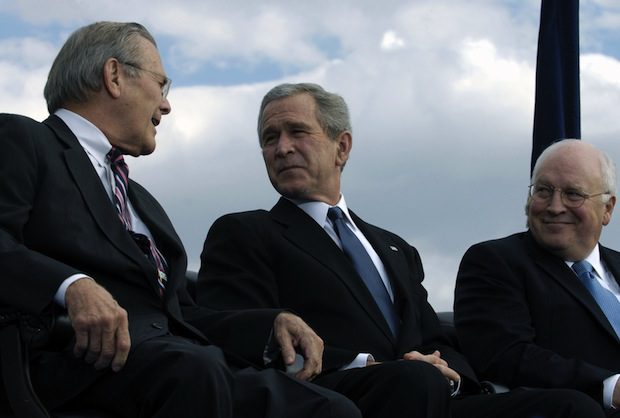Threat Inflation Poisons Our Foreign Policy

John Glaser and Christopher Preble have written a valuable study of the history and causes of threat inflation. Here is their conclusion:
If war is the health of the state, so is its close cousin, fear. America’s foreign policy in the 21st century serves as compelling evidence of that. Arguably the most important task, for those who oppose America’s apparently constant state of war, is to correct the threat inflation that pervades national security discourse. When Americans and their policymakers understand that the United States is fundamentally secure, U.S. military activism can be reined in, and U.S. foreign policy can be reset accordingly.
Threat inflation is how American politicians and policymakers manipulate public opinion and stifle foreign policy dissent. When hawks engage in threat inflation, they never pay a political price for sounding false alarms, no matter how ridiculous or over-the-top their warnings may be. They have created their own ecosystem of think tanks and magazines over the decades to ensure that there are ready-made platforms and audiences for promoting their fictions. This necessarily warps every policy debate as one side is permitted to indulge in the most baseless speculation and fear-mongering, and in order to be taken “seriously” the skeptics often feel compelled to pay lip service to the “threat” that has been wildly blown out of proportion. In many cases, the threat is not just inflated but invented out of nothing. For example, Iran does not pose a threat to the United States, but it is routinely cited as one of the most significant threats that the U.S. faces. That has nothing to do with an objective assessment of Iranian capabilities or intentions, and it is driven pretty much entirely by a propaganda script that most politicians and policymakers recite on a regular basis. Take Iran’s missile program, for example. As John Allen Gay explains in a recent article, Iran’s missile program is primarily defensive in nature:
The reality is they’re not very useful for going on offense. Quite the opposite: they’re a primarily defensive tool—and an important one that Iran fears giving up. As the new Defense Intelligence Agency (DIA) report entitled “Iran Military Power” points out, “Iran’s ballistic missiles constitute a primary component of its strategic deterrent. Lacking a modern air force, Iran has embraced ballistic missiles as a long-range strike capability to dissuade its adversaries in the region—particularly the United States, Israel, and Saudi Arabia—from attacking Iran.”
Iran’s missile force is in fact a product of Iranian weakness, not Iranian strength.
Iran hawks need to portray Iran’s missile program inaccurately as part of their larger campaign to exaggerate Iranian power and justify their own aggressive policies. If Iran hawks acknowledged that Iran’s missiles are their deterrent against attacks from other states, including our government, it would undercut the rest of their fear-mongering.
Glaser and Preble identify five main sources of threat inflation in the U.S.: 1) expansive overseas U.S. commitments require an exaggerated justification to make those commitments seem necessary for our security; 2) decades of pursuing expansive foreign policy goals have created a class dedicated to providing those justifications and creating the myths that sustain support for the current strategy; 3) there are vested interests that benefit from expansive foreign policy and seek to perpetuate it; 4) a bias in our political system in favor of hawks gives another advantage to fear-mongers; 5) media sensationalism exaggerates dangers from foreign threats and stokes public fear. To those I would add at least one more: threat inflation thrives on the public’s ignorance of other countries. When Americans know little or nothing about another country beyond what they hear from the fear-mongers, it is much easier to convince them that a foreign government is irrational and undeterrable or that weak authoritarian regimes on the far side of the world are an intolerable danger.
Threat inflation advances with the inflation of U.S. interests. The two feed off of each other. When far-flung crises and conflicts are treated as if they are of vital importance to U.S. security, every minor threat to some other country is transformed into an intolerable menace to America. The U.S. is extremely secure from foreign threats, but we are told that the U.S. faces myriad threats because our leaders try to make other countries’ internal problems seem essential to our national security. Ukraine is at most a peripheral interest of the U.S., but to justify the policy of arming Ukraine we are told by the more unhinged supporters that this is necessary to make sure that we don’t have to fight Russia “over here.” Because the U.S. has so few real interests in most of the world’s conflicts, interventionists have to exaggerate what the U.S. has at stake in order to sell otherwise very questionable and reckless policies. That is usually when we get appeals to showing “leadership” and preserving “credibility,” because even the interventionists struggle to identify why the U.S. needs to be involved in some of these conflicts. The continued pursuit of global “leadership” is itself an invitation to endless threat inflation, because almost anything anywhere in the world can be construed as a threat to that “leadership” if one is so inclined. To understand just how secure the U.S. really is, we need to give up on the costly ambition of “leading” the world.
Threat inflation is one of the biggest and most enduring threats to U.S. security, because it repeatedly drives the U.S. to take costly and dangerous actions and to spend exorbitant amounts on unnecessary wars and weapons. We imagine bogeymen that we need to fight, and we waste decades and trillions of dollars in futile and avoidable conflicts, and in the end we are left poorer, weaker, and less secure than we were before.
Comments